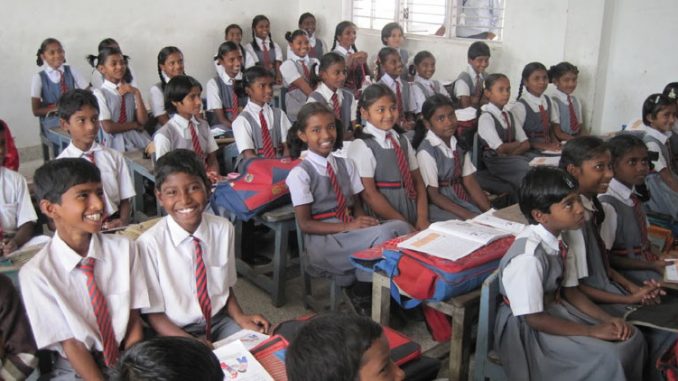
By Anurag Behar
There is no substitute for education’s role in developing a good society. But in the here and now, we need education, and more
One of the hundreds of dusty small towns in north India, this one is not particularly remote. The nearest airport is a two-and-a-half-hour drive on a four-lane highway. Evenings in March are cool in that region, even if the days are turning hot.
This particular evening was cool too, and even with 60 people sitting on the floor, the small room did not feel stuffy. The animated discussion had to be brought to an end at 7.30pm, else it would have continued. Many of the teachers had over 20km to go to reach home. It was the weekly evening discussion of the forum of government-school teachers. This forum is a peer learning group in which teachers engage voluntarily.
Gender equity was the matter being discussed. The veneer of correctness was thin. Everyone, woman and man, in the 2-hour discussion started with only what ought to be said. But the difference between what they felt and what they said was too much. Despite a man and three women holding out till the end with their ideas, the room reached a comforting consensus. Clear affirmation to bringing in total gender equity in some distant future, with a reaffirmation of benign patriarchy for today, satisfied everyone except the small radical group.
Even I felt satisfied—having learnt not to pick red flags like how patriarchy could be benign, instead weighing the progress made within our messy reality. The intense discussion was because these teachers were thinking about matters related to gender in their own milieu. And they were aware of what needs to be changed. This is important. In the absence of teachers having this kind of understanding, education cannot contribute to improving gender equity. For sure, understanding in itself is insufficient, but it is the starting point.
Five hundred metres, to the spot where our car was parked, was a pleasant stroll. A teacher taking the same route home was keeping stride. With a smirk, she said, “Kehne ke liye to kuch bhi keh dete hain, ghar me betiyon ki ungli kaat dete hain (To make a statement they will say anything, but at home they chop off the fingers of their daughters).” She was referring to the male teachers. I asked her what she meant. She said that in that area, when men think that their daughters are becoming “belagaam” (out of their control), they chop off their little finger as a warning. Exaggeration on such matters by both sides, the good and the bad, is routine. My disbelief was apparent, it encountered a smile from her, and we parted ways at the car.
The hotel I stayed in that night was an hour from the airport. Next morning, a junction on the route to the airport had a traffic snarl. There was a weekly haat in a village. As my car crawled, I saw the colourful wares and the shoppers. A few seconds before my car hit the spot where the snarl eased, my eyes fell on a girl sitting in an auto. She must have been 18. She was holding a bag, both hands visible. She had nine fingers. The little finger of her left hand was chopped at the base.
My car surged ahead, her auto raced off into a side lane, and my heart stopped.
The rage in me had no outlet. A colleague confirmed that he too had heard of finger-chopping in that area. But in a country where daughters are routinely killed at birth, as also for their love when they are older, a chopped finger is not even reported.
By the time I landed in Bengaluru, two flights and 6 hours later, the episode had become another stark reminder of the limits of education. We forget that injustice, inhumaneness or the effects of poverty cannot be fought by education alone. Sure, in the long term, there is no substitute for education’s role in developing a good society. But in the here and now, we need education, and more.
In the fourth week of January this year, I was in Bibballi, a village near Sedam, just off the road from Gulbarga to Hyderabad. Three thousand girls had come from the Sedam block to participate in the kishori mela. They had worked in their own schools to develop interesting ways of presenting issues related to gender. Colourful poster displays and creative exhibits filled room after room. Lively music and riveting theatre, both were there. From reproductive health and dietary diversity to female infanticide and constitutional commitments to equity, the range of issues tackled left very few unaddressed.
With bricks being broken and dust clouds rising owing to the stomping of feet, it was the group of karate girls who best captured the spirit of the mela. Excitement, confidence and courage, energized by being together. Collectively, the strength of the 3,000 girls was way more than the sum of their individual strengths.
Schools as fundamental social institutions, present in every village and small town, can systematically play a role in developing this collective spirit and strength, going beyond what is generally considered in the realm of education. That has been the side effect of the effort in Sedam. Energized by the experience, the teachers and officers present decided to systematically and frequently conduct kishori melas within clusters of schools.
Fires of this kind, if lit in the 1.5 million schools across this country, will make it increasingly difficult to chop off the little finger of a little girl. Till then, my heart remains pierced by that little finger.
Anurag Behar is the chief executive officer of Azim Premji Foundation and leads the sustainability initiatives for Wipro Ltd. He writes every fortnight on issues of ecology and education.
Source: Livemint

Leave a Reply